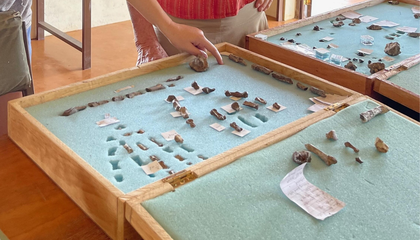A groundbreaking study by Abhrojyoti Mazumder, a Ph.D. student at Carnegie Mellon University, is paving the way for innovations in quantum computing and communication networks through his research on gold nanoclusters. These carefully engineered materials, created in a lab, hold the potential to enhance the speed and efficiency of light transmission, which is crucial for modern telecommunications and national security.
Mazumder’s work centers on the unique properties of gold nanoclusters, which range from 24 to 96 atoms in size and possess tunable optical characteristics. Unlike traditional nanoscale materials, such as quantum dots or carbon nanotubes, gold nanoclusters are produced with exceptional uniformity and minimal defects. This quality makes them ideal for applications in quantum and photonic technologies.
Revolutionizing Communication with Gold Nanoclusters
As the demand for faster and more reliable communication systems grows, the ability to transmit light with greater precision becomes imperative. According to Mazumder, gold nanoclusters can be integrated into photonic chips designed for telecommunication wavelengths. This integration would enable seamless interactions with the spectral bands used in fiber-optic systems.
Mazumder collaborated with professors Linda Peteanu and Rongchao Jin to explore the optical properties of these nanoclusters. Their research indicates that the uniformity and defect-free nature of gold nanoclusters could lead to the development of quantum and photonic chips that are more efficient and easier to manufacture. “We hope in the future, they can be integrated into photonic chips engineered to operate at telecommunication wavelengths,” Mazumder stated.
In experimental conditions, the team discovered that gold nanoclusters emitted electromagnetic waves efficiently within the same area of the spectrum used in traditional telecommunications. This phenomenon suggests that they could significantly enhance communication speed and efficiency.
Building the Foundation for Quantum Innovation
The development of quantum computers relies heavily on stable single-photon emitters, which are essential for using particles of light, or photons, as qubits. Mazumder’s research shows that certain gold nanoclusters can effectively generate stable single photons. “They can generate single photons efficiently with a very high purity,” he explained, highlighting their potential as ideal emitters for future quantum technologies.
Furthermore, Peteanu noted the broader implications of Mazumder’s findings, stating that while the journey from material discovery to practical applications is often complex, the insights gained from this research will enhance our understanding of light emission mechanisms in nanoclusters. This knowledge could eventually lead to applications in bioimaging and other advanced technologies.
Recognizing the strategic significance of his research, Mazumder received the McWilliams Fellowship, an honor awarded to graduate researchers whose work contributes to cutting-edge science in fields like nanotechnology. “Abhro is not only highly productive but also exceptional at initiating new projects,” Peteanu remarked, emphasizing Mazumder’s ability to collaborate effectively across disciplines.
Mazumder expressed gratitude for the fellowship and the mentorship he has received from both Peteanu and Jin. “I’m really excited to further investigate these nanoclusters and explore their potential practical applications in next-generation quantum technologies,” he said.
As research continues, Mazumder’s work stands to make significant contributions not only to the field of quantum computing but also to global efforts in secure communications and scientific advancement. The implications of these findings are vast, underscoring the importance of innovative materials in shaping the future of technology.







